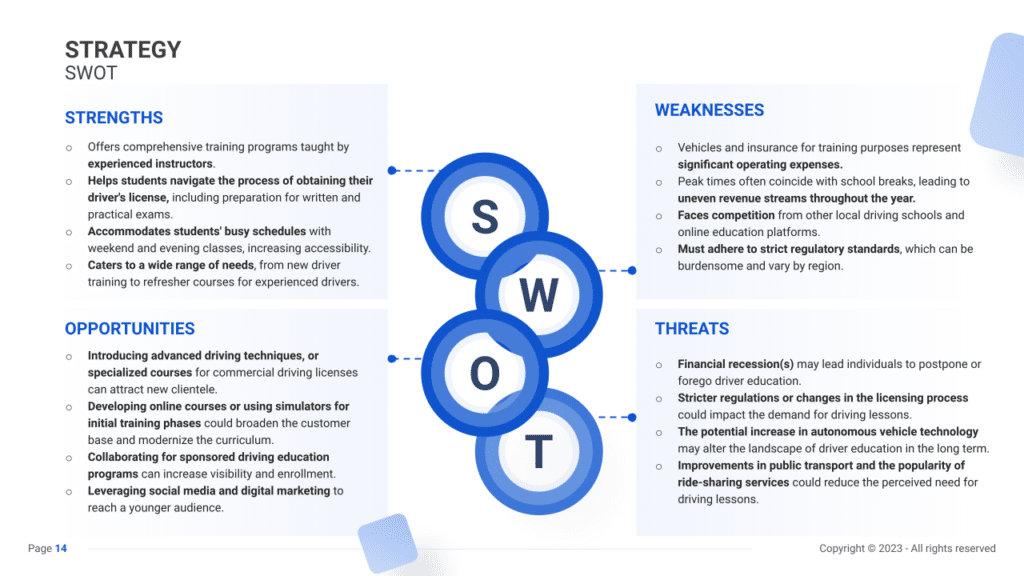SWOT Analysis Example for a Driving School

A SWOT analysis is crucial for developing a business plan for a driving school. This analysis, which stands for Strengths, Weaknesses, Opportunities, and Threats, helps in understanding both internal and external factors that can impact your business. Strengths and weaknesses are internal to the business, while opportunities and threats are external.
In this article, we will explore various examples of strengths, weaknesses, opportunities, and threats, aiding driving school owners in incorporating these insights into their business strategies. Let’s dive in!

Strengths
Highlight the strengths that set your Driving School apart, ensuring effective and safe driving education.
- Experienced Instructors: Having a team of skilled and experienced instructors is a major strength, attracting learners who value quality education.
- Example: Showcase your instructors’ credentials and success stories on your website and in marketing materials.
- Comprehensive Training Programs: Offering a wide range of driving courses, from beginner to advanced, appeals to various learner needs.
- Example: Promote the diversity of your training programs, highlighting specialized courses like defensive driving.
- Modern Training Vehicles: Utilizing modern and well-maintained vehicles can enhance the learning experience and safety.
- Example: Feature your fleet of vehicles in your promotional content, emphasizing their safety features and modern technology.
- Strong Safety Record: A proven track record of safety can be a significant competitive advantage.
- Example: Publicize your safety statistics and student pass rates to build trust and credibility.
Weaknesses
Address weaknesses to strengthen your Driving School for enduring success.
- Limited Vehicle Availability: A small fleet can limit your capacity to take on new students.
- Example: Plan for a gradual expansion of your fleet to accommodate more learners without compromising quality.
- Geographical Limitations: Operating in a limited area can restrict your market reach.
- Example: Explore opportunities for expanding your service area or offering mobile training options.
- Seasonal Fluctuations: Demand for driving lessons can be seasonal, affecting consistent business flow.
- Example: Offer off-season promotions or specialized training courses to attract learners throughout the year.
- Marketing Challenges: Inadequate marketing efforts can limit your school’s visibility and growth.
- Example: Develop a targeted marketing strategy that includes online presence, local advertising, and community engagement.
Opportunities
Seize opportunities to drive growth and innovation in your Driving School.
- Technological Advancements: Incorporating driving simulators and online learning tools can modernize the training experience.
- Example: Invest in simulation technology and develop online course materials to enhance learning options.
- Partnerships with Local Organizations: Collaborating with schools, colleges, and businesses can lead to group training contracts.
- Example: Establish partnerships with local organizations to offer exclusive group rates or customized training programs.
- Expanding to New Markets: Targeting different demographics, such as senior drivers or commercial vehicle training, can open new revenue streams.
- Example: Research and develop specialized training programs for niche markets within the driving education field.
- Regulatory Changes: Changes in driving laws and regulations can create a need for updated or additional training.
- Example: Stay informed about regulatory changes and adapt your curriculum to meet new requirements, offering refresher courses as needed.
Threats
Prepare for potential threats to ensure the resilience of your Driving School.
- Competitive Market: The driving school market can be highly competitive, with many schools competing for clients.
- Example: Focus on differentiating your school through unique teaching methods, specialized courses, or superior pass rates.
- Economic Downturns: Economic challenges can affect clients’ ability to afford driving lessons.
- Example: Offer flexible payment plans or discounted package deals to accommodate clients with budget constraints.
- Technological Disruptions: The rise of autonomous vehicles could potentially impact the future demand for traditional driving lessons.
- Example: Monitor technological trends in the automotive industry and consider offering courses related to new vehicle technologies.
- Changes in Licensing Requirements: Shifts in licensing processes or requirements can impact the demand for certain courses.
- Example: Adapt your course offerings to align with any new licensing requirements, ensuring your training remains relevant and necessary.





